
The Wright brothers, Orville Wright and Wilbur Wright, were American aviation pioneers generally credited with inventing, building, and flying the world's first successful motor-operated airplane. They made the first controlled, sustained flight of a powered, heavier-than-air aircraft with the Wright Flyer on December 17, 1903, four miles south of Kitty Hawk, North Carolina, at what is now known as Kill Devil Hills. The brothers were also the first to invent aircraft controls that made fixed-wing powered flight possible.
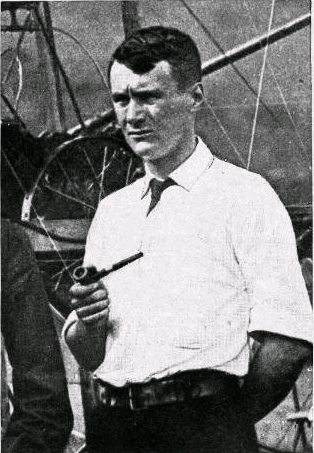
Thomas Etholen Selfridge was a first lieutenant in the U.S. Army and the first person to die in an airplane crash. He was also the first active-duty member of the U.S. military to die in a crash while on duty. He was killed while seated as a passenger in a Wright Flyer, on a demonstration flight piloted by Orville Wright.
This is a list of aviation-related events from 1905:

The Curtiss-Wright XP-55 Ascender is a 1940s United States prototype fighter aircraft built by Curtiss-Wright. Along with the Vultee XP-54 and Northrop XP-56, it resulted from United States Army Air Corps proposal R-40C issued on 27 November 1939 for aircraft with improved performance, armament, and pilot visibility over existing fighters; it specifically allowed for unconventional aircraft designs. An unusual design for its time, it had a canardconfiguration towards the nose, a rear-mounted engine, swept wings, and two vertical tails.Because of its pusher design, it was satirically referred to as the "Ass-ender". Like the XP-54, the Ascender was designed for the 1,800hp Pratt & Whitney X-1800 24-Cylinder H-engine, but was redesigned after that engine project was canceled. It was also the first Curtiss fighter aircraft to use tricycle landing gear.
The Wright Flyer III was the third powered aircraft by the Wright Brothers, built during the winter of 1904–05. Orville Wright made the first flight with it on June 23, 1905. The Flyer III had an airframe of spruce construction with a wing camber of 1-in-20 as used in 1903, rather than the less effective 1-in-25 used in 1904. The new machine was equipped with the engine and other hardware from the scrapped Flyer II and, after major modifications, achieved much greater performance than Flyers I and II.

The Beechcraft Model 18 is a 6- to 11-seat, twin-engined, low-wing, tailwheel light aircraft manufactured by the Beech Aircraft Corporation of Wichita, Kansas. Continuously produced from 1937 to November 1969, over 9,000 were built, making it one of the world's most widely used light aircraft. Sold worldwide as a civilian executive, utility, cargo aircraft, and passenger airliner on tailwheels, nosewheels, skis, or floats, it was also used as a military aircraft.

The Douglas DC-4E was an American experimental airliner that was developed before World War II. The DC-4E never entered production due to being superseded by an entirely new design, the Douglas DC-4/C-54, which proved very successful.

The Airco DH.4 is a British two-seat biplane day bomber of the First World War. It was designed by Geoffrey de Havilland for Airco, and was the first British two-seat light day-bomber capable of defending itself.
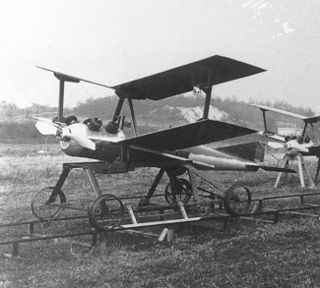
The Kettering Bug was an experimental unmanned aerial torpedo, a forerunner of present-day cruise missiles. It was capable of striking ground targets up to 75 miles (121 km) from its launch point, while traveling at speeds of 50 miles per hour (80 km/h). The Bug's costly design and operation inspired Dr. Henry W. Walden to create a rocket that would allow a pilot to control the rocket after launch with the use of radio waves. The British radio controlled weapons of 1917 were secret at this time. These designs were forerunners of modern-day missiles.
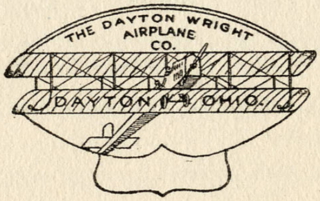
The Dayton-Wright Company was formed in 1917, on the declaration of war between the United States and Germany, by a group of Ohio investors that included Charles F. Kettering and Edward A. Deeds of Dayton Engineering Laboratories Company (DELCO). Orville Wright lent his name and served as a consultant, but other than that, the location of one of its three factories in the original Wright Company factory buildings in Dayton, Ohio was the only connection to the Wright brothers. In addition to plant 3, Dayton-Wright operated factories in Moraine and Miamisburg, Ohio. During the course of the war, Dayton-Wright produced about 3,000 DH-4s, as well as 400 Standard SJ-1 trainers. The company was hurt by the reputation of the DH-4s it produced as "flaming coffins" or "flying coffins", although they were not in reality more subject to catching fire than other aircraft, and by scandals it faced.
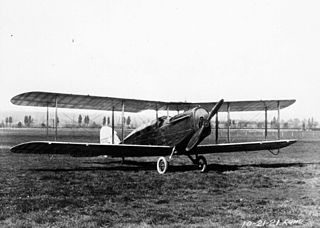
The Dayton-Wright KT Cabin Cruiser was a 1920s American three-seat touring aircraft built by the Dayton-Wright Airplane Company in Dayton, Ohio. Often known as the "Honeymoon Express", it was one of several civilian aircraft the company developed from the de Havilland DH.4.

The Wright Model B was an early pusher biplane designed by the Wright brothers in the United States in 1910. It was the first of their designs to be built in quantity. Unlike the Model A, it featured a true elevator carried at the tail rather than at the front. It was the last Wright model to have an open-frame tail. The Model B was a dedicated two-seater with the pilot and a passenger sitting side by side on the leading edge of the lower wing.

The Curtiss Eagle was an airliner produced in small numbers in the United States shortly after World War I. The aircraft was a conventional biplane with three-bay, unstaggered wings of equal span. The fuselage was a very advanced design for its day, incorporating careful streamlining of its monocoque structure, and offering the crew as well as the passengers a fully enclosed cabin. The Eagle is sometimes named as the first American tri-motor aircraft; however Curtiss' own Model H flying boat flew with three engines for a time in 1914 before being converted back to twin-engine configuration.

The Dayton-Wright T-4 Messenger was a light, single-seat reconnaissance aircraft built in the United States by the Dayton-Wright Company in 1918 in the hope of gaining a production contract from the United States Army. It was a small conventional single-bay biplane with a neatly streamlined fuselage and staggered, equal-span wings. The undercarriage was of fixed tailskid type and the pilot sat in an open cockpit. Although diminutive, the design in fact started life as a scaled-up version of the Dayton-Wright Bug and shared a family resemblance to the de Havilland DH.4 that Dayton-Wright was building under licence during World War I. When the US Army was not interested in the aircraft, plans were made to sell it on the civil market, but these came to nothing and the prototype was the only example ever built.

The Fairchild FC-1 and its derivatives were a family of light, single-engine, high-wing utility monoplanes produced in the United States in the 1920s and 1930s. The aircraft was originally designed to provide a camera platform for Sherman Fairchild's aerial photography and survey business, Fairchild Aerial Surveys.

The Kalinin K-4 was an airliner built in the Soviet Union in the late 1920s which was also adapted for use as a photographic survey aircraft and as an air ambulance. A further development of the K-1, it was a conventional high-wing, strut-braced monoplane with separate enclosed cabin and cockpit. Kalinin undertook the design to offer a locally produced alternative to pioneering Ukrainian airline Ukrvozdukhput, which was at that time flying Dornier designs. The structure was of mixed wood and metal construction, but with major assemblies designed in both wood and metal versions, allowing them to be interchanged. The design also featured a variable-incidence horizontal stabiliser, and the engine mounting was intended to facilitate the ready interchange of different powerplants.
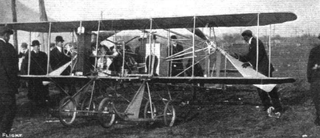
The Wright Model R was a single-seat biplane built by the Wright Company in Dayton, Ohio, United States, in 1910. Also known as the Roadster or the Baby Wright, it was designed for speed and altitude competitions.
The California Coupe, also called the Royer & Montijo California Coupe, was an early cabin biplane built in California. It was built in part using parts from a crashed Dayton-Wright OW.1, the last aircraft designed by one of the Wright Brothers. The California Coupe flew in early 1924, but the next year it was damaged in a failed stunt on a movie set. Montijo and Royer were not recompensed, so the company folded and the designed was not developed further.

The Dayton-Wright FS was a two-seat trainer that first flew in 1917. This was the first aircraft manufactured by the Dayton-Wright Company. The FS was originally known as the 'first shot' since it was the company's 'first shot' at making an aircraft. Harold Talbott, Sr., the company's president, decided later to abbreviate it to FS.


















